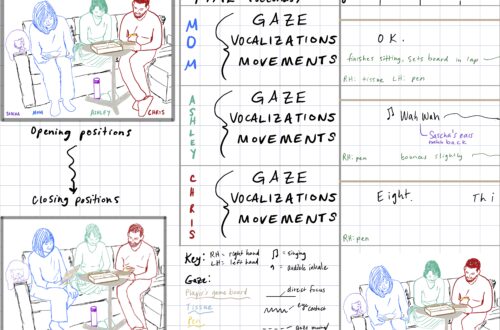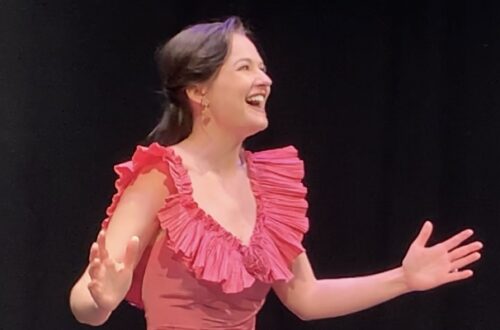A Description and Analysis of the Crossover Classical Vocalist Speech Community
[Assignment prompt: using only your personal experience as a source, identify, document, and analyze a speech community that you participate in as a part of your daily life, per John J. Gumperz’s 1968 article “The Speech Community,” International Encyclopedia of the Social Sciences. New York: Macmillan, pp. 381-6.]
.
“eeeeEEE ooOOO! Whoop! Whoop! Bzzzzz… Zuh! roAR!”
Newcomers are often surprised by the cacophony of vocalizations that greet them upon entering one of my community’s primary domains. While strolling through orderly rows of small, semi-soundproofed, glass-fronted enclosures, visitors may observe a single subject lying on the floor, flopped in half like a ragdoll, standing, arms raised in victory, or possibly manipulating the face: nose pinched, tongue sticking out, cheeks smushed… This description clearly orients us in the jungle of a musical community – specifically, a college practice room hall, filled with budding singers.
This paper provides a basic description and analysis of one sector of the larger musical arts and entertainment industry, which I term the Crossover Classical Vocalist Community (CCVC). Despite close interaction with related communities, I propose that the CCVC is a distinct speech community based on specialized verbal repertoire, comprising dialectical variation (especially in the form of technical jargon to express in-group concepts) and superposed variation – namely, speech events that occur exclusively within this group.
Crossover Classical Vocalists (CCVs) are singers trained in and skilled at performing classical music as well as musical theatre and other non-classical repertoire (crossover genre). Kristin Chenoweth is one of the best-known examples of a CCV master. Training is essential for this group not merely to develop vocal technique; it is also the primary way singers acquire the language that makes them members of the speech community. CCVs will continue to use this language throughout their careers in diverse speech events.
When considering shared, unique language usage and regular interaction as the basis for a speech community (Gumperz), one realizes that the CCVC also comprises members who are not CCVs (though CCVs form its core and are the focus of this paper). Others, such as conductors, vocal coaches, and enthusiasts, may indeed have sufficient training in group concepts and language to actively use its verbal repertoire and to participate in CCVC speech events. These members occupy different roles within the community and may have limited participation in certain speech events. Conversely, there may be proficient singers who do not share significant linguistic features of the group (e.g., self-taught, non-classically trained), and thus would not be considered CCVC members. Members often interact in ways that further a common goal: to develop skills that enable CCVs to perform diverse material publicly. It is through language and practice that skill is primarily achieved.
Membership is not limited by geographical boundaries, native language, ethnicity, gender, or socio-economic conditions, though those circumstances may affect a person’s access to the community. Geographically, CCVs are most prevalent where there is a thriving musical theatre community: namely the USA and UK (though Germany and the Netherlands also have significant musical theatre opportunities). Musical theatre is one of the most common crossover domains, since many musical theatre styles require skill in or familiarity with classical technique (consider Phantom of the Opera, works by Sondheim or Rogers and Hammerstein). There is also significant demand for CCVs in concert settings (including vocalists in some military bands, who are expected to deliver excellent performances in a wide range of genres, often within the same concert).
The CCVC developed to meet the changing demands of the music industry. Membership is most defined by the training necessary to develop its specific skill set of vocal flexibility, which has resulted in a distinct dialectical language variation. As classical music is arguably the most technically and vocally demanding, it is common for a CCV to begin training as a classical singer and then crossover to other genres. While members are often initiated into the community in a similar way – private voice lessons in youth, followed by college and/or advanced degrees in music performance – it is possible to enter the community in other ways. What is essential is exposure to and eventual fluency in the CCVC verbal repertoire and mastery of technical skills so that one may participate in group speech events.
With their shared foundation in classical technique, the CCVC is most closely related, especially linguistically, to the broader community of classical singers. CCVs diverge when they acquire additional skills and language from other communities, such as those of musical theatre, jazz, and pop. The crossover singing variety will likely have significant differences in technique and jargon, and singers must learn and adapt to these new forms, while still retaining their classical skills – and especially, be able to switch between styles and verbal repertoire quickly. This breadth of interdisciplinary knowledge is key in differentiating CCVs from members of other groups.
Much of the CCVC’s verbal repertoire belongs to the common language, but has been appropriated to communicate something specific – often a concept non-members would find difficult to interpret without significant training, practice, and experience. Examples are elaborated in the glossary.
The CCVC draws knowledge and terminology from various domains (a variety of musical genres and more distantly-related communities like acting and dance) to create an expansive verbal repertoire. While some of this terminology is unique and exclusive to each source community, occasional overlap can create confusion. Additionally, some elements of classical training may impede the understanding of certain crossover concepts, requiring an alterative semantic approach to a crossover genre from that of a singer native to the community. This results in some conceptual modification, incorporating both classical and crossover-genre terminology. All of these elements combine to create the CCVC dialectical variation.
For example, “speak-singing” technique exists in both classical and musical theatre genres – but indexes a completely different meaning in each group. In musical theatre, that direction points to a very “natural” delivery, little-to-no vibrato, sound somewhat thrown away; in a classical context, it indicates a “typical” full, supported sound, but greater flexibility for personal interpretation of timing, and minimal accompaniment (as is common in operas and oratorios in the form of recitativo and Sprechgesang). The CCV is aware of both meanings and their associated applications. Linguistic variation appears in the concepts used to teach each technique. In this case, a new term is not invented; the distinctions are understood based on the context.
As previously stated, training is the primary means of acquiring CCVC language, which frequently takes the form of a speech event called a private voice lesson. The private instructor is one of the most influential figures in a singer’s growth; singers frequently receive private training throughout the entire span of their careers. It is vital that student and teacher have compatible communication styles.
The voice cannot be approached like another instrument, which can be seen or touched. Verbal communication is paramount to vocal development, as visual imagery is the primary means in which technique can be shared. Nearly all singing technique is taught through expressions that guide a student to desired physical sensations.
Variation in singing technique can be the most difficult aspect to learn without a knowledgeable instructor, though the necessary stylistic modifications are often simple to understand and produce. The most essential cross-genre elements of technique are breath and placement (specific techniques vary). When teaching a student how to better manage breath stamina and smoothness, an instructor may ask the student to “imagine that the breath is a very long, silk thread that you continue to pull and pull very slowly and evenly throughout the entire phrase.” Concepts stemming from financial advice like “saving and spending” are also common: “You always want to save your breath first to make sure you have enough to last through the phrase – then at the end you can spend what’s left! If you spend too much early on, you might not have any left later.” In terms of placement, a CCV instructor would often refer to color variation and mouth shape – modifying the typical tall, round mouth shape desirable in classical singing to a flatter, more closed mouth for musical theatre and pop genres. Plugging the nose can assist with this modification to accentuate forward placement.
The above concepts and many more foundational skills are taught and reinforced in a private voice lesson. Skills relating to CCV technique (especially the language used to convey particular instructions) are expected to be firmly grasped before a CCV engages in other types of common speech events which may be more formal in tone, including group rehearsals, private coachings, and auditions. An opera director or choral conductor may make artistic requests for “longer phrasing” or a “brighter sound,” but would not anticipate needing to explain how to do this to the CCV (and may be unwilling or unable to do so). Similarly, a coaching is a private session designed to work on artistic interpretation rather than technique, as the coach is not required to have vocal-specific training.
CCV auditions (somewhat similar to a job interview) are often crossover domain events: they take place in a source community (e.g., a musical theatre, opera, or acting audition) – thus, CCVs need to pay careful attention to norms and terminology of the specific community in which they are presently participating. Norms are not always clarified on an audition posting; at a singing audition, a CCV must know the difference between singing “16 bars” and a full song, and that it is inappropriate to ask an accompanist to transpose a piece. Additionally, it would not be acceptable to arrive at an audition involving dance without specialized footwear and clothing, or to not know the difference between “marking” and performing “full out.” Terms from acting, including blocking and choices need to be understood and accessible. Tech staff should not need to explain their directions surrounding microphone checking and usage to a CCV (though they may to a classical vocalist). CCVs need to transition effortlessly between the many communities in which they participate.
The CCVC holds a unique position in the broader musical arts and entertainment industry. Its goal is to prepare singers to perform in a demanding range of genres and contexts, and linguistic elements play a vital role in achieving this goal.
Based on all of the preceding, I assert that the CCVC is a
unique speech community. CCVC members
interact frequently to perform a variety of activities, including but not
limited to speech events, such as those that promote training (voice and group
lessons) and those that refine music (rehearsals and coachings), culminating in
performances, where content is shared publicly.
They use common language aggregated (and sometimes modified) from various
source domains, to communicate group-specific concepts. The CCVC’s verbal repertoire is distinct
because those contributing domains contain subsets, but not the entirety, of
the CCVC’s.
.
Glossary
All of the following are selections from common CCVC verbal repertoire, but as it is the skill of classical singing that unites the group, I have chosen the majority of these terms from that domain. Terms 1-11 would frequently be used in speech events such as private voice lessons, though they may also be heard at group rehearsals for classical repertoire (e.g., operas, choral ensembles, etc.), in which another party who is well versed in vocal technique instructs or directs a singer. It would be unusual, though possible, to hear terms 1-10 in crossover settings, such as musical theatre rehearsals. Terms 12 and 13 would almost exclusively be heard in crossover, rather than classical, settings.
Breath:
“You need to support it!”
- Support (verb, noun):
Refers to the breath, especially its function in creating and sustaining the voice, which is foundational to healthy singing. Training the body to support the voice with the breath requires consistent and life-long practice. Mastery of this technique is essential for performing classical repertoire, but also highly advantageous for crossover situations, as it promotes greater stamina and vocal longevity.
“Don’t collapse.”
- Collapse (verb):
Also refers to the breath, particularly when sustaining a long note or singing a descending passage of notes. One must maintain and often increase energy in the breath and tone, fighting the natural urge to relax, let go, and collapse the openness of the ribs and chest cavity.
Placement:
“Place it [higher]” or “Put it in the mask.”
- Placement (noun; “place” and “put” are both used as verbs to indicate placement):
Refers to where a certain pitch/es should be produced in the skull for optimal resonance, ease of singing, and effect/artistry. Since the voice is not an instrument that can be seen or touched (like a piano), much visual imagery is used to describe technique.
- Mask (noun):
Area in the front of the face around the nose and cheekbones, where many notes should be placed, or felt. Except for occasional artistic effect, singers strive for “forward” placement (forward, referring to being “in the mask”).
“Pay attention to how you’re attacking that.”
- Attack (noun, verb):
The initiation of a note, or the technique employed when one begins singing a note. This could include anatomical references (e.g., a glottal attack) or instructions regarding placement (as in pinpointing, defined below).
“Pinpoint the note.”
- Pinpoint (verb):
Refers to a placement strategy of attacking a note, often a pitch that is high, quiet, and/or difficult to sing. The singer imagines the note in one tiny, specific area and initiates it very softly and precisely to establish proper placement. Once placement has been homed in, the singer can crescendo to the desired volume and more easily and efficiently produce the note.
“Don’t let it drop.”
- (Let) Drop (verb):
Allowing the placement of a sustained note or connected passage of notes to change – particularly deteriorate (to get “lazy,” similar to collapsing, due to lack of energy or concentration to sustain the ideal placement).
Miscellaneous:
“Create a consistent timbre.”
- Timbre (noun):
The unique sound quality of an individual’s voice (also used to describe other instruments). One desires a consistent timbre across the entire voice (as opposed to varying degrees of development in certain areas, such as strong lower notes and under-developed higher notes).
“It’s in my passaggio.”
- Passaggio (noun):
An area of transition between vocal registers (areas of the voice, including “chest voice” and “head voice”). Notes that lie in a passaggio area are more difficult to produce and require additional practice to develop an even timbre.
“Connect the top and the bottom.”
- Connect (verb):
Refers to both breath and placement technique to keep a consistent sound over a wide range of notes (particularly when there is a large interval leap between notes in the same musical phrase).
“Try coloring that differently. Give me a [tall/flat/round/open/dark/bright] sound.”
- Color (noun, verb) + [adjective]:
A tone’s color describes its affective quality: a “dark” sound may convey age or sadness, while “brightness” could denote youth or happiness. Coloring relates to both artistry and placement, as variations are generally achieved by altering mouth shape. The bracketed adjectives above are examples of imagery used to create different vocal colors (a “round” tone would sound more classical – or perhaps, pompous or proper – whereas “flat” placement, which creates additional brightness relative to the degree of flatness, would almost exclusively be used in musical theatre or other crossover performance).
“Try that again with a different choice.”
- Choice (noun):
An artistic approach to presenting material; the unique way a performer portrays a character. This may apply to delivering spoken dialogue, a musical passage, or physical action. Frequently, a director asks an actor to try contrasting approaches to see their range at auditions or experiment with a scene at a rehearsal. One word alone (e.g., “Okay”) could be played to convey love, disgust, eagerness, or fear, based on an actor’s choice. This particular terminology chiefly pertains to the acting community and would rarely be heard in any classical music setting (including opera). “It was a choice” is often how actors jokingly describe an attempt that went poorly.
“From the top! A 5, 6, 7, 8…”
- “5, 6, 7, 8” used as a count in/cue (noun, verb):
Many performance communities use a form of counting in (or counting down) as a cue to begin some action. The “5, 6, 7, 8” language of counting in applies exclusively to dance, as dancers often group choreography in “counts” or sections of 8.



